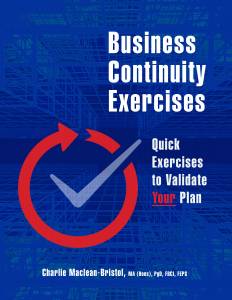Closing and Reopening Offices, Restaurants, and Retail Outlets, after an Incident
Charlie Maclean-Bristol discusses his recent exercises around reassuring customers after an incident and talks about how businesses should approach reopening.
A critical consideration for a crisis team following a major incident is the closure and reopening of offices, restaurants, or retail outlets.
Recently, I conducted an exercise in which we explored two scenarios, both resulting in the crisis team deciding to temporarily close down these establishments. During our feedback session, we delved into the question of how to reassure both staff and customers when it’s time to reopen and ensure their safety.
In the case of a natural disaster or a building fire, once you rebuild and refurbish the facility, persuading customers to return may not be too challenging. The refurbished premises convey a sense of security, and while staff and customers might have some residual concerns, overall, they should feel reassured.
However, the situation becomes more complex when you close individual offices, restaurants, retail outlets, or multiple locations due to health and safety, food hygiene, regulatory, or security issues. How do you convince both staff and customers that it’s safe to return to work or dine out? This dilemma also arose as organizations encouraged employees to return to offices after the COVID-19 pandemic. Despite numerous precautions, organizations couldn’t guarantee a completely risk-free environment. The same challenge arises when closing offices, restaurants, or retail units — how do you persuade people it’s safe to return?
If you’re considering the closure of outlets, it’s crucial to meticulously assess why you’re doing so, which outlets should be closed, what actions will be taken during the closure, and when they might reopen. Reacting impulsively by shutting down all outlets in response to a threat against your organization can have unintended consequences. When you do decide to close outlets, you must clearly communicate the reasons behind the decision. For instance, if it’s in response to a food contamination outbreak, you close them to perform a deep clean to eliminate contamination and ensure customer and staff safety. Upon reopening, you can communicate a thorough cleaning as the reason for the relaunch.
However, if the closure is due to a threat against the organization, it’s more challenging to demonstrate that the threat has been eliminated and it’s safe to return. In the case of a food contamination outbreak along the supply chain, how do you convince customers that the contamination won’t recur and that it’s now safe to purchase and consume previously contaminated products?
As part of the preparation for the exercise, I researched the Chipotle Mexican Grill food contamination outbreak in 2015. Chipotle, known for its commitment to fresh ingredients and fast-food speed, faced a major crisis when E. coli and norovirus outbreaks were linked to their restaurants. They took several actions to relaunch their brand and restaurants as the outbreak became national news in the USA:
- Chipotle voluntarily closed 43 restaurants in Washington and Oregon, where the outbreak was most concentrated. This immediate action aimed to prevent further contamination and demonstrate the company’s commitment to food safety.
- They collaborated closely with health authorities at the local, state, and federal levels, providing full access to their restaurants, supply chain, and food preparation processes for thorough inspections and testing. Transparency was a key pillar of their response; they even had a webcam positioned in one of their food preparation areas so anyone could view their food preparation.
- They implemented a series of food safety measures, including enhanced food handling and preparation protocols, employee training programs, and stricter sourcing standards for ingredients. They also enlisted external food safety experts to improve their practices.
- Chipotle launched a marketing campaign, “Food With Integrity,” to reassure customers about their commitment to quality and safety. They emphasized their use of fresh, locally sourced ingredients and transparency in their supply chain.
- The company temporarily removed certain ingredients, such as fresh coriander and some types of tomatoes, from their menu to address concerns about contamination sources. These items were reintroduced only after thorough testing and safety checks.
- To entice customers back to their restaurants, Chipotle offered various promotions, including free burritos and discounts. They introduced a loyalty scheme with free food offers mainly targeting loyal customers.
The reopening of outlets should be part of an overall recovery strategy, demonstrating to customers that the issue has been taken seriously, shortcomings addressed, and the steps taken to protect customers and staff have been communicated. If customers have shifted to other brands or providers, a marketing campaign should accompany the relaunch.
In conclusion, the decision to close offices, restaurants, and retail outlets should be carefully considered. The reasons for closure must be clearly communicated, along with the intended outcomes of the closure. Reopening should be part of a coordinated campaign, possibly including marketing efforts, to entice customers back. Like all aspects of good business continuity planning, the more forethought given to actions before they occur, the more effective the response and the smaller the impact.
++++++++++++++++++++++++++++++++++++++++++++++++
This article was originally published by BC Training Ltd.
Charlie Maclean-Bristol is the author of the book, Business Continuity Exercises: Quick Exercises to Validate Your Plan
“Charlie drives home the importance of continuing to identify lessons from real-life incidents and crises, but more importantly how to learn the lessons and bring them into our plans. Running an exercise, no matter how simple, is always an opportunity to learn.” – Deborah Higgins, Head of Cabinet Office, Emergency Planning College, United Kingdom


